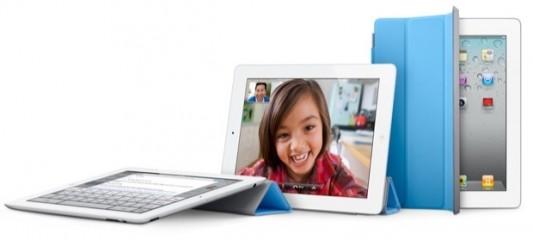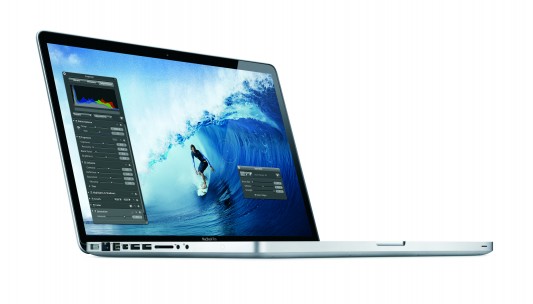iPad 2 was really a 1.5, while Thunderbolt and no Nvidia makes the MacBook Pro update more interesting.
It was a busy seven day for Apple. On February 24 it introduced a refresh to the MacBook Pro line, then on March 2 it got a ton of press for an iPad 2 launch where the biggest surprise was the appearance of Steve Jobs, otherwise on sick leave. Of the two, we find the MacBook Pro refresh more intriguing.
In reality, iPad 1.5
Let’s get past the buzz factor and take a dispassionate look at iPad 2 first. What we now must call iPad 1 was a truly revolutionary device when introduced April 2010. All by itself iPad transformed the market for tablet computers from ho-hum to hot, selling 15 million units in 2010 and taking 90% of the tablet market.

By comparison iPad 2 is an echo, not a second roar. Our first clue that iPad 2 was not a big upgrade came when reading Apple’s official press release: the new magnetized cover (optional, in polyurethane or leather) was in the headline.
There are nice new features, like the two cameras, enabling iPad users to join the FaceTime two-way video chat fun. iPad 2 is thinner (33%) and lighter (15%). It has a new CPU, the Apple A5, rated as 2x faster and 9x faster for graphics with the power consumption of the original A4 chip. And it has a built-in gyroscope. That’s it. It still retails starting at $499, the 3G models are still sold by both AT&T and Verizon, and it is still magical, if you believe Apple’s spin machine and still like to race to the front door on Easter morning.
This is a product refresh, not an upgrade. Think of it as iPad 1.5. Apple is keeping the momentum going until it can introduce its third-generation product in time for Christmas; iPad 3 will be the wowser everyone expected from #2. If you haven’t yet anted up for an iPad, waiting for iPad 3 might be a good idea.
This refresh gives Apple a chance to tighten its stranglehold on the worldwide supply of touch screens, of which it has already pretty much cornered the market. It will be hard for competitors to bring products to market with any volume and competitive pricing when they can’t get enough touch screens to meet demand; if there is demand to meet. Comparing iPad to Motorola Xoom shows what every other manufacturer is up against. Quoting Jobs at the iPad 2 launch, “Five of these six models are less expensive than $799 [Xoom’s price]. We only have one model that’s more expensive than $799.” Apple’s true magic isn’t in the device, it is in the supply chain.
Thunderbolt from Cupertino
A few years ago Apple made news by being the first computer vendor to offer FireWire. The fast (for its time) input/output technology quickly made FireWire-equipped Macs the must-have device for video editing and other high-throughput graphics applications. Apple was also the first vendor to support USB ports. With the introduction of Thunderbolt, it’s déjà vu all over again.
MacBook Pro is the first computer on the market to include new Thunderbolt I/O technology, developed by Intel with collaboration from Apple. Thunderbolt offers two bi-directional channels with transfer speeds up to 10Gbps each, delivering PCI Express directly to external high performance peripherals such as RAID arrays. It supports existing FireWire and USB devices and Gigabit Ethernet networks via adapters. Thunderbolt also supports DisplayPort for high resolution displays and works with existing adapters for HDMI, DVI and VGA displays.

Thunderbolt is based on work at Intel previously codenamed LightPeak. In a press briefing last week, Intel said the PCI Express protocol was used because it’s flexible and compatible with existing I/O devices. The original plan was to use optical cable, but that was shelved for cost considerations. The new DisplayPort-based I/O uses a single copper connection.
The only way to add Thunderbolt to a computer is via a system or logic board, not an add-in board to an existing PC; Thunderbolt needs direct access to both the system’s video and PCI Express architecture. Thus Intel predicts Apple has a 12-to-18 month lead on other vendors who want to incorporate Thunderbolt.
The new MacBook Pro may be the beginning of the end for Apple’s relationship with Nvidia. This refresh replaces Nvidia graphics processors with Intel HD 3000 on the low end and AMD’s Radeon HD on the high end. Rumors were swirling around Silicon Valley for months that the breakup was imminent. Intel has promised it has learned its lessons about integrated graphics performance with its new Sandy Bridge technology, and there was a high failure rate in some Nvidia notebook chipsets over the last 12 months.
MacBook Pro still comes in 13- 15-, and 17-inch configurations. The 13-inch has either Intel Core i5 or Core i7 dual-core processors up to 2.7 GHz and Intel HD Graphics 3000. The 15-inch and 17-inch models offer quad-core Core i7 processors up to 2.3 GHz and AMD Radeon HD graphics processors (HD 6490M and HD 6750M) with up to 1GB of video memory. The camera is updated to HD quality, and supports Apple’s new FaceTime technology. The aluminum unibody enclosure, glass Multi-Touch trackpad, LED-backlit widescreen display, illuminated full-size keyboard and 7-hour battery are basically unchanged.





